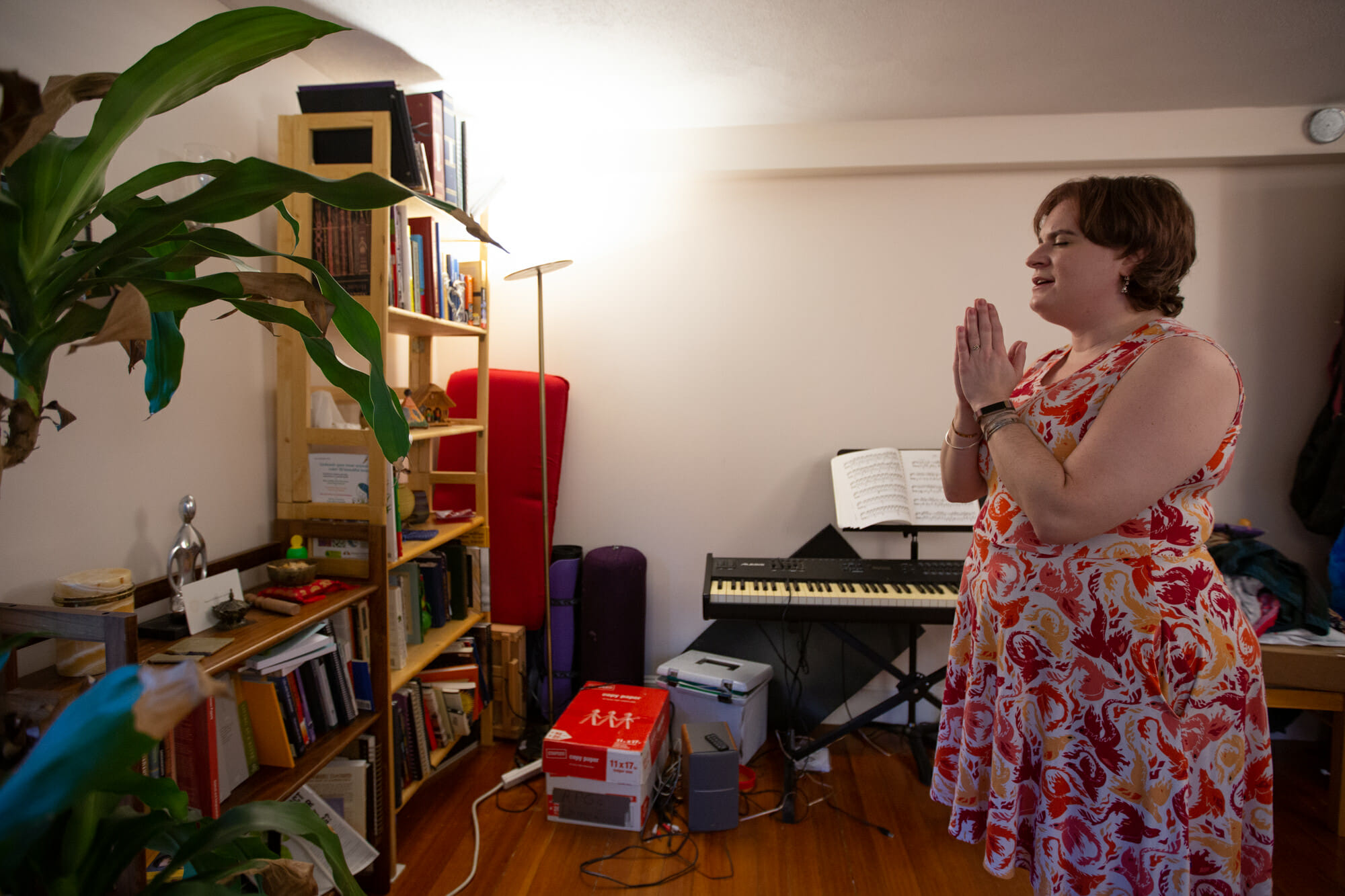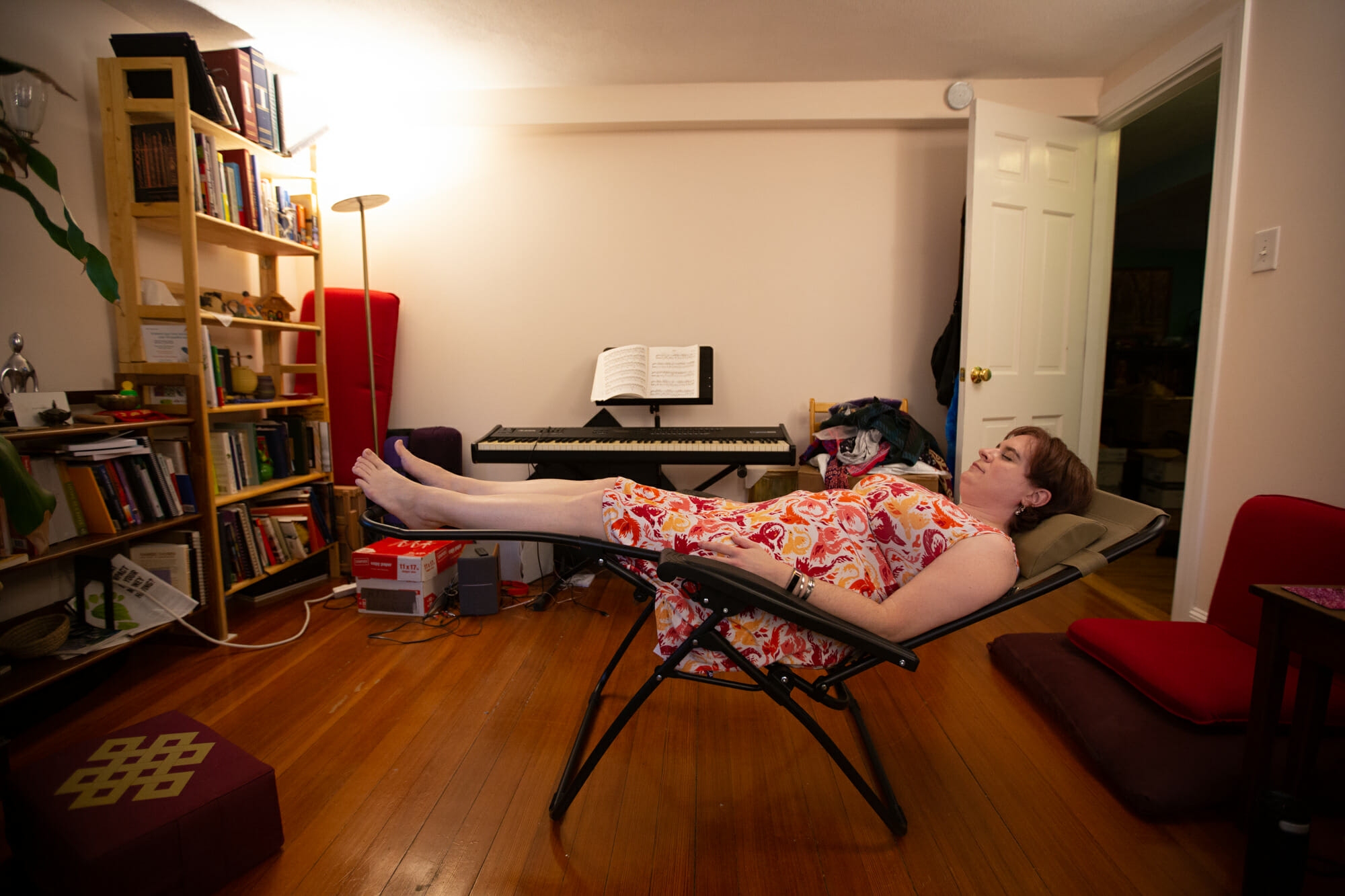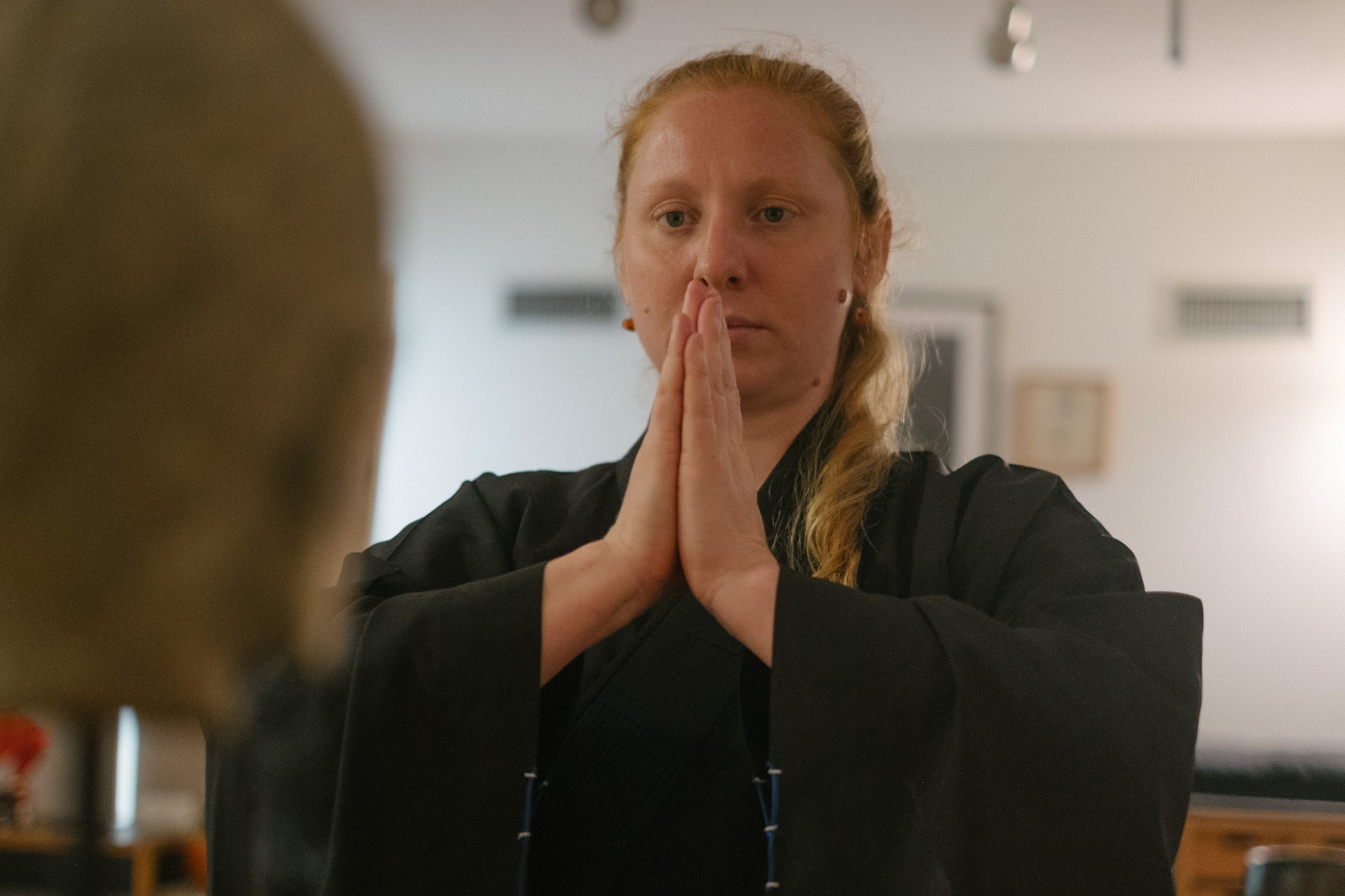When were you first exposed to dharma?
I grew up in a household that exposed me to Catholicism. I became a Catholic as a teenager, by my own choice. But my relationship to Catholicism started to change when the scandals about the abusive priests came out. As time went on, while I appreciated many of the teachings of the church, I didn’t believe in the worship of God anymore.
I became exposed to the dharma when I was dealing with chronic pain. I was required to meditate as part of my treatment, and at the time I couldn’t relax any of my muscles. But the meditation helped me learn to relax. My massage therapist told me it was as if I’d switched bodies. That change was so profound that I got curious about what else meditation could do for me.
An interest in meditation led me to the dharma. The people whose online meditation classes I took were dharma teachers and members of the Triratna order.
I chose to become Buddhist for many reasons. First and foremost, Buddhist teachings make a lot of sense. Sometimes it seems like they are so obvious that it’s strange that living the teachings is so challenging. Buddhism requires me to have faith in my ability to transform myself. Sometimes it is hard, but it is something I can devote myself to.
Buddhism encourages us to try the teachings for ourselves without blind belief. That is important to me. The teachings of ethics are paired with teachings of compassion. This kind of compassion was something I sorely needed. And so in time it was clear to me that I was Buddhist.
How has the path manifest in your daily experience? Does it reflect in your work and relationships?
The Buddhist path only exists in our daily lives. It is something we can work on no matter what else we are doing. And so, it has gradually started to permeate my life. Some big changes for me since starting to practice 10 years ago are: becoming more compassionate to myself, becoming less of a workaholic, being less interested in distraction, and carrying myself more lightly in my endeavors. I’ve learned to work less hard, to strive with less grasping, and that has helped in both my work as a software developer and a song writer.
In my relationships, both those that are personal, and in other places, I make more of an effort to rejoice in the merits of the people I encounter. I’m learning how to argue without a goal of being right – but instead a goal of trying to understand the other person’s point of view. This has changed my life at work dramatically.
If you explore other lineages within buddhism, how did you come to decide on which lineage was right for you?
I looked into other lineages after encountering Triratna, but in the end it turned out that the sangha I was looking for was the one I started with. Triratna is an order that is less based in Eastern Culture, which is important to me because I don’t want to be appropriative. It’s an order with an emphasis on: scholarship into the Pali Canon and relying on the fundamentals that underlie most lineages; a foundation in going to refuge to the Buddha, the Dharma, and the Sangha; engaging with the arts as a form of inspiration; living in the world (it is a lay order).
I also have been very inspired by the way that the order makes decisions that are helping it grow and change. It has historically been a place where gay and lesbian people were welcomed even in times where that was rare. The order is now working on how to make sure that non-binary and transgender people are also welcomed and feel included. This is among many of the challenges the order faces as it grows and changes with the times.
How long/often do you meditate? How has it evolved over the years?
I wish I was more of a regular meditator. But for me, my practice is fundamentally in the moment. It is taking opportunities to be kind when I’d otherwise ignore people – my Lyft driver, the security guard at work, cashiers, etc. It is noticing when I get caught up and learning to release my grasping.
Retreats are very important for me to keep being inspired, and I go to them when I can, but that is hard in a world with so little vacation time.
More than anything else, the thing that keeps my practice alive is my sangha community. I have a weekly sangha that I only manage to go to when I am well, but I also have a smaller subgroup that meets at my house twice a month for dharma study. I have a few friends in the order and in the training for ordination program that I stay in touch with. And I luckily have three great local order members that I talk to fairly regularly.
Which sangha do you normally attend ?
There have been times when I’ve been much more focused on dharma study and meditation, but I had no sangha. My practice didn’t get very far. The people that I study and practice with challenge me to look at my views, to understand my grasping, and to notice when I reject things out of fear. They also help me realize how much I’ve changed and help me by rejoicing in my merits.
The second is that the teachers I met were people I really connected to because we had a lot in common. My local sangha leader worked in my field for a long time, and has similar personality quirks to mine. It really helped me to see that people like myself were not only benefitting from practice, but were able to commit themselves to it so wholly.
What is your primarily profession?
I work as a software developer who writes code that tests code. I manage a team of others who work on the same project.
The thing about being a problem solver for a living is that you can become very focused on systematic approaches to solving problems. You can collect all the data you can, and still be stymied. You try to explore every avenue. But what can really bring breakthroughs is spaciousness, because it lets you become creative. To become creative you have to accept that you don’t have everything figured out. I think often about the story of the monkey who can’t get his fist out of the jar because he is holding on to a treat. I’ve learned to lighten my grip and that often can give me the creativity to solve problems.
I’ve also become more patient, and that sounds like a small thing but it’s really made a difference for my creative work. I get ideas as a song writer, but I can’t always make them work when I want to write them. Sometimes I just have to let go of the idea that a given song will work. Sometimes I need to just wait and give my creative mind a chance to breathe. Weeks can go by and nothing happens, and then suddenly there the song is. In my old life I wouldn’t have had the patience to let these things materialize.
Do you think your personality or background influence the lineage/practices that resonate with you?
The first lineage that I felt really driven to join was Shambala. I was very attracted to the program and the orderliness of it. It seemed very well constructed. But I realized after I first started to take a look at it, that my ego was drawn to the sense of accomplishment each step might give me. While I knew that wasn’t the reason the program was designed that way, I realized it wasn’t quite right for me.
I think there were two pieces to my personality and background that made Triratna really attractive. The first is that Triratna’s teachings are focused on those of us from the West. That is really helpful when you are trying to learn things counter to Western culture, like self compassion, and how to stop grasping. This focus made me feel like the teachings were more approachable.
Background
Lisa reluctantly turned to Buddhism when she grappled with chronic pain, initially resisting meditation prescribed by her therapist. Despite her apprehensions, the practice transformed her body and led her to explore Buddhist meditation techniques. Intrigued, she delved into the Dharma, finding resonance in the lineage of Triratna.
The founders of her community, Triratna, had a unique approach. Having studied various traditions, they recognized the challenge of integrating the Dharma into the Western context. They emphasized separating cultural traditions from the core practices, aligning more closely with the original teachings such as the Pali canon. Lisa shared this sentiment, believing that adopting a foreign culture as part of her practice would be disingenuous.
In the current landscape, Garage Charter places a significant emphasis on creative and artistic expression, a distinctive aspect of their approach. This focus on creativity has become an integral and enriching part of Lisa’s Buddhist practice. As she navigates this unique territory, she finds solace and authenticity in a community that aligns with her values and allows her to embrace Buddhism without compromising her cultural identity.
Lineage
In the world of Triratna, formerly known as the Friends of the Western Buddhist Order, Lisa navigates a unique lay order that underwent a name change to accommodate its growing global membership. Despite variations in practice from center to center, Triratna operates as a non-hierarchical order. Order members, once initiated, participate in decision-making through consensus.
The sangha, or community, plays a pivotal role in Triratna , with gatherings often inclusive of friends who may not have committed to a Buddhist lifestyle. In Lisa’s Boston sangha, a tight-knit group of around 15 regular members meets regularly at the Boston Theosophical Society. Their practice involves chanting, meditation, and communal discussion of a chosen book, fostering a space for shared exploration and the cultivation of right listening.
Spiritual friendship, a cornerstone of Triratna, is emphasized over a teacher-centric approach. The sangha places importance on connecting with peers, even during silent retreats. Lisa appreciates the focus on mutual learning and improvement within the community, a departure from a more traditional teacher-student dynamic. Retreats, although not mandatory, are highly encouraged, ranging from short weekends to more extended solo retreats for experienced practitioners.
For those in training for ordination like Lisa, special retreats are designed to deepen their commitment to a Dharma-centered life. These retreats aim to align practitioners with the three jewels—Dharma, Buddha, and Sangha—as the focal points of their lives. In Triratna , the emphasis on community, shared exploration, and ongoing learning creates a unique and enriching experience for Lisa and others in the sangha.
Impact
In Lisa’s journey with mindfulness practice, she grapples with her workaholic tendencies in the high-tech industry. Transitioning to a 40-hour workweek didn’t alleviate her constant preoccupation with work-related stress. Seeking relief from chronic pain, she underwent monitoring that revealed the positive impact of meditation on her autonomic nervous system. However, the realization that she remained excessively focused on work outside meditation prompted a shift in perspective.
To combat her workaholic nature, Lisa consciously worked on being less reactive and implemented changes in her approach. Taking a week off from work marked a significant transformation, allowing her to disengage from work-related thoughts outside office hours. Despite maintaining her love for her job, Lisa developed the ability to leave work at the office, bringing newfound balance to her life.
Notably, this change in Lisa’s behavior extended to her managerial role. Recognizing her own negative tendencies, she began assisting her team in prioritizing tasks and managing stress. Her colleagues observed a lighter and more compassionate approach in her leadership.
Beyond the professional realm, Lisa’s mindfulness practice impacted her interactions with others. Overcoming a commuter attitude adopted in Boston, she consciously engaged with people, making eye contact and acknowledging their presence. A dharma teacher’s suggestion to carry small amounts of cash facilitated moments of generosity and compassion toward those in need, transforming her perspective on the world.
As Lisa navigates the challenges of an upcoming election, she reflects on her changed attitude towards differing political views. Formerly wrapped up in the intensity of the political landscape, she now sees people with differing opinions as individuals with diverse perspectives rather than enemies. This shift allows her to approach political discussions with openness and humility, acknowledging the potential fallibility of her own beliefs. The practice, for Lisa, has evolved beyond the cushion, influencing her work-life balance, leadership style, and interactions with the broader world.
Deepening
Lisa initially resisted the idea of asking for ordination, feeling the need to be absolutely ready and certain before taking such a significant step. However, a fellow practitioner undergoing ordination training provided a perspective shift. He pointed out that the very things Lisa desired in her practice—more support, increased contact with order members, additional retreats, and further training—were integral aspects of ordination training. This realization helped her understand that the journey itself was valuable, regardless of whether ordination ultimately occurred.
Once Lisa embraced this perspective, it eased the pressure and allowed her to approach the idea of ordination more lightly. Instead of fearing the commitment of becoming an order member, she recognized that she could start with the initial step of seeking deeper involvement in the practice.
Being someone with a busy schedule and health issues, Lisa acknowledged the ease with which focus could be lost, especially when unable to attend Sangha. Retreats became crucial in challenging her and pushing her views in ways she wasn’t doing on her own. In particular, recent retreats have challenged her concept of self-compassion. Initially perceiving it as a common Buddhist greeting, Lisa eventually grasped the significance when fellow retreatants pointed out her lack of self-compassion. This revelation was initially challenging for her, as she had sought a different kind of discipline, but the retreat setting allowed the idea to sink in over the course of several days.
Lisa values the retreat process for the opportunity it provides to have her views challenged and to receive assistance in bringing the Dharma more deeply into her life. She recognizes that the support and challenges encountered during retreats are unique and might not be as accessible in regular life. Overall, the process is helping her grow and understand aspects of her practice that might have been overlooked otherwise.
Meditation Tech
Lisa, an avid practitioner of mindfulness, initially approached it as a tool for relaxation and, more recently, to calm her nervous system. Being technologically inclined, she utilizes tools like the Muse sensing headband, which reads brain signals and indicates focus through bird sounds. While recognizing the benefits of various mindfulness tools for health and stress reduction, Lisa emphasizes the importance of integrating ethics into mindfulness practice.
In Lisa’s view, mindfulness, when divorced from ethical considerations, may fall short in its transformative potential. Mindfulness often focuses on being aware of the present moment but may not delve into how personal views shape perceptions. Lisa highlights the need to explore the underlying reasons behind emotions or reactions, such as potential biases or preconceived notions.
Lisa contends that the separation of mindfulness from ethical precepts limits its ability to penetrate deeply into one’s psyche. She underscores the common goals among Dharma practitioners, regardless of lineage, emphasizing the shared recognition that alleviating suffering involves addressing ethical considerations. Lisa sees ethical guidelines like right speech, right action, and right livelihood as frameworks to reduce suffering rather than mere rules.
Acknowledging that many individuals turn to mindfulness to alleviate suffering, Lisa asserts that solely paying attention to the present moment lacks the structural support to break free from ingrained perspectives. She believes that mindfulness courses, even those addressing deeper issues, benefit from the support of a community practicing together. In Lisa’s perspective, having experienced individuals and a supportive community fosters the necessary environment for individuals to challenge their views, ultimately leading to a reduction in suffering.
Practice
Lisa, an enthusiast of mindfulness, engages in various meditation practices within the Tree Ratna community. While she occasionally meditates for 25 minutes during her daily commute, her practice intensifies, lasting up to an hour, especially after returning from retreats. Over the ten years of her meditation journey, Lisa has observed the blending of different meditation techniques, with her sessions now typically beginning with a body-focused self-compassion center.
Lisa’s meditation practices include mindfulness of breathing, the Brahma Viharas (loving-kindness, compassion, sympathetic joy, and equanimity), and Skylake Mind, which involves opening oneself to whatever experiences arise without fixating on them. A notable transformation for Lisa has been in mindfulness of breathing. Previously perceiving it as solely a concentration practice, she now recognizes its embodiment within the body, particularly after engaging in voice movement therapy and breath-related physical health practices.
Skylake Mind, a practice that encourages openness and spaciousness of the mind, has been illuminating for Lisa. It helps her notice the fragmented nature of her thoughts, especially her strong inner narrative, providing a valuable perspective on the interconnectedness of thoughts.
The Brahma Viharas, especially kindness (metta), hold significance for Lisa. While the practice involves cultivating compassion, kindness, equanimity, and sympathetic joy towards oneself and others, Lisa emphasizes the challenge individuals often face in extending self-compassion. This practice has been foundational for her, influencing her initial steps into Buddhist meditation.
In discussing meditation practices, Lisa acknowledges variations in terminologies, such as Skylake Mind being referred to as “just sitting” within the Tree Ratna community. She finds group meditation to be particularly beneficial, offering support and a shared experience. Overall, Lisa’s evolving meditation journey emphasizes creativity, interconnectedness of practices, and the importance of ethics and compassion within mindfulness.















































































